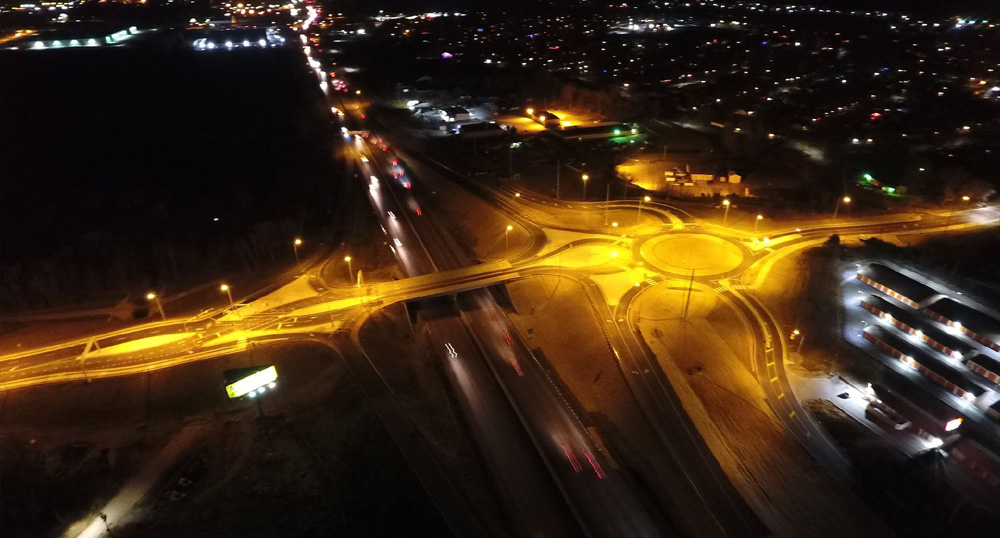A new interchange concept, technology to improve winter maintenance, accelerated bridge construction (ABC), and unmanned aerial systems (UAS) are among the innovations States used in projects recognized in the 2019 America’s Transportation Awards competition.
Sponsored by the American Association of State Highway and Transportation Officials (AASHTO), AAA, and U.S. Chamber of Commerce, the annual competition showcases projects State transportation departments deliver to better serve their customers.
The Missouri Department of Transportation (MoDOT) deployed an innovative interchange concept called a “divergabout” at Interstate 49 and 155th Street in the Kansas City area. The concept combines the benefits of a diverging diamond interchange (DDI) and a roundabout, reducing the number of left-turn conflict points and enhancing safety. MoDOT design engineers tailored the divergabout for interchanges with high traffic volumes and increased risk of serious crashes.
The first of its kind, the divergabout project reconstructed the interchange to replace the bridge over I-49 with a solution to handle future traffic increases while accommodating current traffic. The project features a DDI that switches 155th Street traffic onto the left side of the bridge to allow for better traffic flow and a roundabout coupled to the DDI that enables motorists to access the outer roads and 155th Street smoothly in all directions. The project added a shared-use path to the interchange to increase safety for pedestrians and bicyclists. MoDOT reports reduced congestion at the divergabout location and plans to conduct a future safety analysis. The agency built a second divergabout at U.S. 50 and Missouri Route 291 South in the Kansas City area.
 The Missouri Department of Transportation built the world’s first divergabout to improve safety and traffic flow at Interstate 49 and 155th Street in the Kansas City area.
The Missouri Department of Transportation built the world’s first divergabout to improve safety and traffic flow at Interstate 49 and 155th Street in the Kansas City area. Using a weather-responsive management strategies approach, the Nebraska Department of Transportation (NDOT) leveraged technology to manage highway clearance operations and help motorists make safer travel decisions during winter weather. The project installed maintenance decision support system (MDSS) and automatic vehicle location technology on NDOT’s 633 snowplow trucks. With this system, NDOT maintenance managers can access weather and pavement models, plow truck locations, dashboard camera views of roadway conditions, and information on the amount of salt and other materials spread.
Snowplow operators receive roadway treatment recommendations, weather forecasts, weather radar maps, and instant messages from NDOT managers via the system. Recommendations are updated hourly to reflect changing road and weather conditions, optimizing resource use and ensuring that trucks spread materials efficiently across the State’s highways. An online Plow Tracker shows the location of active snowplow trucks and their camera images, providing a tool to help motorists make informed travel decisions.
The New Hampshire Department of Transportation (NHDOT) and town of East Kingston chose ABC technologies to rehabilitate a structurally deficient bridge in an accelerated timeframe without disrupting train service underneath it. Originally built in 1937 and last rehabilitated in 1969, the bridge carries 2,200 vehicles a day over a commuter rail line. NHDOT and East Kingston received Accelerated Innovation Deployment Demonstration funds to deploy prefabricated bridge elements (PBEs) and ultra-high performance concrete (UHPC), technologies they had not used before.
The project reconstructed the bridge superstructure and repaired the piers and abutments. The bridge deck used PBEs constructed offsite and transported to the bridge site for rapid installation. Crews poured UHPC between the deck panels to create strong, long-lasting connections. The bridge was closed to vehicle traffic while the project was underway to expedite construction. The project was finished in 25 days—3 days ahead of schedule—instead of an entire season for conventional construction.
The North Carolina Department of Transportation (NCDOT) deployed UAS technology to monitor and document flooding, road conditions, and traffic impacts after Hurricane Florence struck in 2018. More than a dozen NCDOT drone teams flew more than 260 missions and captured more than 8,000 photos and videos of the damage and flooding left behind by the storm.
NCDOT provided the drone-collected data, images, and video to Federal, State, and local agencies through a custom-designed online dashboard, a portal that also allowed the department to share information with the public via traditional and social media. The project helped agencies make real-time decisions on providing emergency response, planning detour routes, assessing repair needs, expanding disaster declarations, and warning the public of potential dangers on roadways. This was the first time drones had been used to monitor a disaster in North Carolina and the first time they were used at such a scale in the United States.
Contact Maggie Kasperski of AASHTO for information on America’s Transportation Awards.
- Cover
- Accelerated Bridge Construction Changes How Transportation Agencies Do Business
- New Jersey, Pennsylvania, and Washington Win STIC Excellence Awards
- States Innovate
- Agents for CHANGE
- Innovations Help States Deliver Outstanding Transportation Projects
- Visualize Rural Roadway Departure Countermeasures With Trading Cards
- About Innovator
